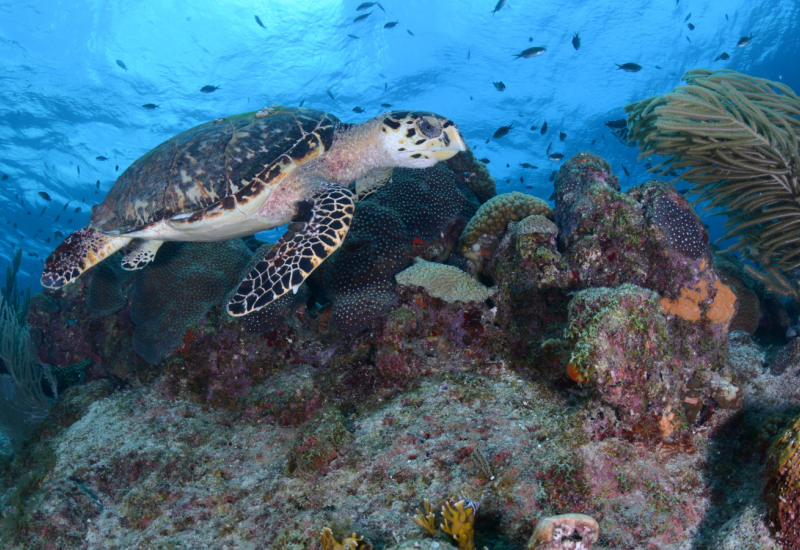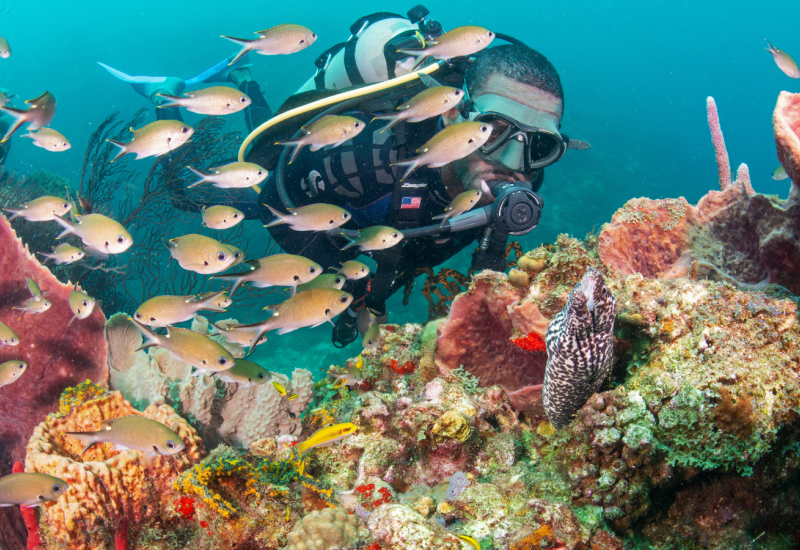Southern California's Oil Rigs
November 2007
Text by Brandon Cole
Off the Southern California coast lies an eyesore-or a beauty. If you're a diver who regularly straps a tank onto your back, odds are good you'd vote for the latter. If your gig is selling multimillion-dollar Pacific Ocean views to the stars, the former.
Southern California's oil rigs are a study in contrasts. The lifeless metal that looms above the waterline transforms into a vibrant artificial reef below. With open ocean stretching in all directions, the rigs are a marine life oasis, among the most prolific dive sites in California.
Eureka
Seventy feet down, roughly at knee level, we're gazing up at a giant wearing hot-pink pants. Swathed in strawberry anemones, Eureka's legs command our complete attention. There must be billions of the tentacled, jewel-like Corynactis californica, and dozens upon dozens of fist-sized scallops are within grabbing distance. Checkered calico bass and a pack of halfmoons buzz past us. Acorn barnacles and sponges are filter feeding everywhere. Sculpins and gobies scoot along the plush polychrome turf. Pushed here by current, the drifting larvae of these and countless other whatsits settled on the rig, set up shop and are now thriving.
Kicking laterally along a crossbeam, we search in vain for some unclaimed real estate. The platform's sharp steel, its ponderous pilings and riveted struts are gone, obscured by marine life that has attached itself like Velcro. Twenty-three oil platforms breach the waters off the coast between Oceanside and Santa Barbara. Their names are mostly feminine (e.g., Eva, Grace, Harmony), but at night they belch fire-petroleum and natural gas. They are also great dive sites-Eureka and its sister platforms are now artificial reefs extraordinaire.
Ellen-Elly
A natural encore to Eureka is the nearby double rig, Ellen-Elly. In 260 feet of water eight-and-a-half miles off Long Beach, Ellen-Elly looks out of place, like some amphibious space station. Our boat backs in close to the superstructure. A healthy swell wraps around the pilings, and sea lions woof loudly at our intrusion. The captain yells, "Dive, dive, dive!"
We pile into the water and surface swim to the nearest leg. Engulfed in shadow, we deflate and descend amidst the drone of the working platform surrounding us. The same sea lions who were perturbed a moment ago are now curious and friendly. Showoffs, they spiral around us, spinning through their own bubble trails and then rocketing away. No doubt we'll have better luck impressing the bucktoothed sheephead or cabezon milling about. The bug-eyed cabezon is on a beam overgrown with foot-long, muscular ebony mussels. The cab doesn't budge-even when we zoom in to within inches of its rubbery lips.
Twenty minutes into the dive, and we've hardly moved either, enthralled by the colorful microcosm of macro life. We slip deeper on a diagonal, passing through a thermocline and a visocline. The temperature drops six degrees to 56, but the vis opens up to 75 feet. The platform's three-dimensional "jacket" snaps into focus. The fisheye view of Ellen's underside is mesmerizing. A shimmering snake made up of thousands of silvery fish weaves through the silhouetted crisscrossing supports.
The current is building, so we duck behind a beefy piling. In the lee of Ellen's leg, we begin our ascent. There's a lot to see on the way up: jellies pulsing past, two crabs locked together, oversized sea stars and puppydog-loyal sheephead shadowing our every move.
At 15 feet, we level out and angle into the center of the rig for our safety stop. We poke along, our masks pressed close to the action. Nudibranchs are on the move, and rainbow-hued brittle stars are waving feathery arms at us. Then we run smack- dab into a garibaldi whose orange color is as bold as his attitude. He wastes no time in charging us repeatedly. Obviously, we've just trespassed into his 'hood.
There are two sides to every story. As to what I think regarding the tangle of controversy surrounding Southern California's oil rigs-whether to rip them out or let them remain-I'll choose to look below the surface. There's beauty indeed under these beasts.
InDepth
Diving the rigs requires special permission. It's far easier to join a group such as Reef Seekers (www.reefseekers.com) on a permitted charter boat than to arrange things on your own. Anchoring is impractical due to depth, and tying off to the rig is prohibited. Therefore, live-boating is essential. In general, this is intermediate level diving. Surge is common. Visibility can be 10 feet one day, 100 the next, with 40 to 60 feet the average. Currents, too, are ever-changing and can be strong, but it's nearly always possible to shelter behind pilings and girders. Pay attention to safe procedures for entries, exits and underwater navigation. (Orientation is primarily visual-your compass will likely be useless next to these colossal magnets.) Be vigilant for crew boats coming and going. The best marine life is found from the surface down to about 80 feet. Techies can push 200-feet-plus on the rigs. Prime diving season is generally June through December.
Access Eureka, Ellen and Elly on charter boats leaving San Pedro and Long Beach. Boats leave Santa Barbara and Ventura to dive platforms Grace (10-and-a-half miles offshore) and Holly (two miles out). For a list of charter boats, check www.californiadiveboats.com.
November 2007
Text by Brandon Cole
Off the Southern California coast lies an eyesore-or a beauty. If you're a diver who regularly straps a tank onto your back, odds are good you'd vote for the latter. If your gig is selling multimillion-dollar Pacific Ocean views to the stars, the former.
Southern California's oil rigs are a study in contrasts. The lifeless metal that looms above the waterline transforms into a vibrant artificial reef below. With open ocean stretching in all directions, the rigs are a marine life oasis, among the most prolific dive sites in California.
Eureka
Seventy feet down, roughly at knee level, we're gazing up at a giant wearing hot-pink pants. Swathed in strawberry anemones, Eureka's legs command our complete attention. There must be billions of the tentacled, jewel-like Corynactis californica, and dozens upon dozens of fist-sized scallops are within grabbing distance. Checkered calico bass and a pack of halfmoons buzz past us. Acorn barnacles and sponges are filter feeding everywhere. Sculpins and gobies scoot along the plush polychrome turf. Pushed here by current, the drifting larvae of these and countless other whatsits settled on the rig, set up shop and are now thriving.
Kicking laterally along a crossbeam, we search in vain for some unclaimed real estate. The platform's sharp steel, its ponderous pilings and riveted struts are gone, obscured by marine life that has attached itself like Velcro. Twenty-three oil platforms breach the waters off the coast between Oceanside and Santa Barbara. Their names are mostly feminine (e.g., Eva, Grace, Harmony), but at night they belch fire-petroleum and natural gas. They are also great dive sites-Eureka and its sister platforms are now artificial reefs extraordinaire.
Ellen-Elly
A natural encore to Eureka is the nearby double rig, Ellen-Elly. In 260 feet of water eight-and-a-half miles off Long Beach, Ellen-Elly looks out of place, like some amphibious space station. Our boat backs in close to the superstructure. A healthy swell wraps around the pilings, and sea lions woof loudly at our intrusion. The captain yells, "Dive, dive, dive!"
We pile into the water and surface swim to the nearest leg. Engulfed in shadow, we deflate and descend amidst the drone of the working platform surrounding us. The same sea lions who were perturbed a moment ago are now curious and friendly. Showoffs, they spiral around us, spinning through their own bubble trails and then rocketing away. No doubt we'll have better luck impressing the bucktoothed sheephead or cabezon milling about. The bug-eyed cabezon is on a beam overgrown with foot-long, muscular ebony mussels. The cab doesn't budge-even when we zoom in to within inches of its rubbery lips.
Twenty minutes into the dive, and we've hardly moved either, enthralled by the colorful microcosm of macro life. We slip deeper on a diagonal, passing through a thermocline and a visocline. The temperature drops six degrees to 56, but the vis opens up to 75 feet. The platform's three-dimensional "jacket" snaps into focus. The fisheye view of Ellen's underside is mesmerizing. A shimmering snake made up of thousands of silvery fish weaves through the silhouetted crisscrossing supports.
The current is building, so we duck behind a beefy piling. In the lee of Ellen's leg, we begin our ascent. There's a lot to see on the way up: jellies pulsing past, two crabs locked together, oversized sea stars and puppydog-loyal sheephead shadowing our every move.
At 15 feet, we level out and angle into the center of the rig for our safety stop. We poke along, our masks pressed close to the action. Nudibranchs are on the move, and rainbow-hued brittle stars are waving feathery arms at us. Then we run smack- dab into a garibaldi whose orange color is as bold as his attitude. He wastes no time in charging us repeatedly. Obviously, we've just trespassed into his 'hood.
There are two sides to every story. As to what I think regarding the tangle of controversy surrounding Southern California's oil rigs-whether to rip them out or let them remain-I'll choose to look below the surface. There's beauty indeed under these beasts.
InDepth
Diving the rigs requires special permission. It's far easier to join a group such as Reef Seekers (www.reefseekers.com) on a permitted charter boat than to arrange things on your own. Anchoring is impractical due to depth, and tying off to the rig is prohibited. Therefore, live-boating is essential. In general, this is intermediate level diving. Surge is common. Visibility can be 10 feet one day, 100 the next, with 40 to 60 feet the average. Currents, too, are ever-changing and can be strong, but it's nearly always possible to shelter behind pilings and girders. Pay attention to safe procedures for entries, exits and underwater navigation. (Orientation is primarily visual-your compass will likely be useless next to these colossal magnets.) Be vigilant for crew boats coming and going. The best marine life is found from the surface down to about 80 feet. Techies can push 200-feet-plus on the rigs. Prime diving season is generally June through December.
Access Eureka, Ellen and Elly on charter boats leaving San Pedro and Long Beach. Boats leave Santa Barbara and Ventura to dive platforms Grace (10-and-a-half miles offshore) and Holly (two miles out). For a list of charter boats, check www.californiadiveboats.com.










